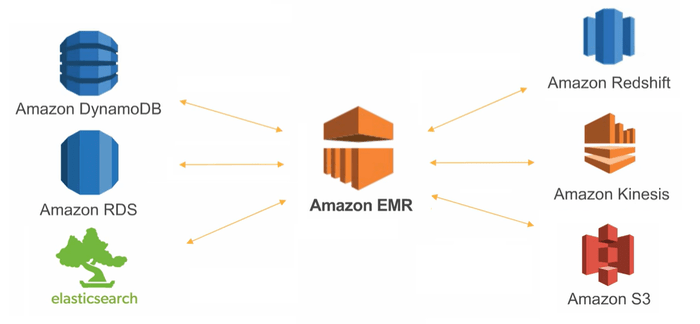In the modern age of data, businesses and organizations are generating and collecting enormous volumes of data. Extracting meaningful insights from this data requires advanced processing capabilities that can handle the sheer scale and complexity of information. This is where AWS Elastic MapReduce (EMR) shines, offering a scalable and efficient solution for processing big data using popular frameworks such as Apache Spark, Hadoop, and more. In this article, we will delve deep into the world of big data processing with AWS EMR, exploring its core concepts, features, benefits, and real-world applications.
Understanding AWS EMR
AWS Elastic MapReduce (EMR) is a cloud-based service provided by Amazon Web Services that simplifies the processing and analysis of vast amounts of data. EMR allows organizations to create and manage clusters of virtual machines, known as instances, which are optimized for executing big data frameworks. These frameworks enable efficient distribution and parallel processing of data across the cluster, leading to quicker insights and analytics. If you’re looking to harness the power of AWS EMR for your data processing needs and need skilled developers to set up and manage these clusters, explore https://lemon.io/hire-aws-developers/ to find experts in AWS technologies.
EMR supports a wide range of popular big data frameworks, including:
- Apache Hadoop: A framework for distributed storage and processing of large datasets across clusters of computers.
- Apache Spark: A fast and versatile open-source data processing and analytics engine.
- Apache Hive: A data warehousing and SQL-like querying tool for big data.
- Apache Presto: An open-source distributed SQL query engine designed for interactive analytics.
Key Features of AWS EMR
1. Easy Cluster Management
EMR simplifies the process of setting up, configuring, and managing clusters for big data processing. With just a few clicks in the AWS Management Console, users can create and configure clusters tailored to their specific needs. EMR also provides support for launching clusters using APIs and AWS CloudFormation templates, enabling infrastructure as code practices.
2. Scalability
One of the standout features of EMR is its ability to scale resources based on the demands of the data processing workload. Whether you’re dealing with terabytes or petabytes of data, EMR can dynamically add or remove instances from the cluster to ensure optimal performance and resource utilization.
3. Data Security and Isolation
EMR clusters can be deployed within Amazon Virtual Private Cloud (VPC), providing network isolation and control over inbound and outbound traffic. This enhances the security of data during processing, making EMR suitable for sensitive workloads.
4. Integration with Other AWS Services
EMR seamlessly integrates with various other AWS services, such as Amazon S3 for scalable storage, Amazon RDS for relational databases, and AWS Glue for data cataloging and ETL (Extract, Transform, Load) operations.
5. Managed Hadoop Ecosystem
AWS EMR manages the complexities of running a Hadoop cluster, including installing, configuring, and optimizing the Hadoop ecosystem components. This allows users to focus on their data and analytics tasks rather than the operational overhead.
6. Cost Efficiency
EMR enables cost optimization through the use of Amazon EC2 Spot Instances, which can significantly reduce compute costs for fault-tolerant and flexible workloads.
Benefits of Using AWS EMR
1. Rapid Data Processing
EMR’s parallel processing capabilities enable faster data processing, which is crucial for time-sensitive insights and analytics.
2. Flexibility
EMR supports a variety of big data frameworks, allowing users to choose the best tool for their specific use case.
3. Scalability
The ability to scale clusters up or down based on workload requirements ensures efficient resource utilization and cost savings.
4. Managed Infrastructure
EMR takes care of the operational aspects of cluster management, allowing users to focus on data analysis and processing.
5. Integration with AWS Ecosystem
EMR seamlessly integrates with other AWS services, enabling users to build end-to-end data pipelines and analytics solutions.
Real-World Applications of AWS EMR
- Log Analysis and Processing: Organizations can use EMR to process and analyze log data from various sources, extracting insights for troubleshooting, security analysis, and performance optimization.
- E-commerce Recommendation Engines: EMR can power recommendation systems for e-commerce platforms, processing user behavior data to provide personalized product recommendations.
- Genomic Data Analysis: In the field of bioinformatics, EMR can be used to analyze large-scale genomic datasets, aiding in research related to genetics and personalized medicine.
- Clickstream Analysis: Websites and online platforms can leverage EMR to analyze clickstream data, understand user behavior, and optimize user experiences.
- Fraud Detection: EMR can be employed to analyze transaction data and detect patterns indicative of fraudulent activities, enhancing security measures for financial institutions.
Getting Started with AWS EMR
To get started with AWS EMR, follow these steps:
- Define Your Use Case: Identify the data processing requirements and the appropriate framework (e.g., Hadoop, Spark) for your use case.
- Choose Your Data Sources: Determine where your data resides, whether it’s in Amazon S3, an external database, or other sources.
- Create an EMR Cluster: Use the AWS Management Console, AWS CLI, or CloudFormation to create an EMR cluster with the desired configuration.
- Submit Jobs: Once your cluster is up and running, submit your data processing jobs using the chosen framework’s APIs or command-line tools.
- Monitor and Optimize: Monitor your cluster’s performance using Amazon CloudWatch and optimize its resources based on workload demands.
Conclusion
AWS EMR empowers organizations to unlock insights from their big data quickly and efficiently. With its robust features, scalability, and integration with the AWS ecosystem, EMR has become a go-to solution for data processing, analytics, and complex computations. Whether you’re analyzing customer behavior, conducting scientific research, or optimizing business processes, AWS EMR provides the tools you need to harness the power of big data and turn it into valuable insights that drive informed decisions.
By embracing AWS EMR, businesses can stay at the forefront of the data-driven revolution and capitalize on the transformative potential of their data assets. As the world continues to generate ever-increasing amounts of data, AWS EMR stands as a vital tool for deriving actionable insights and staying competitive in a data-centric landscape.


